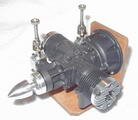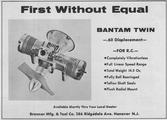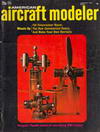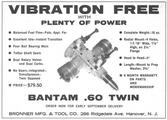|
|
A number of the designers and manufacturers of successful selling single cylinder model airplane engines during their histories got the "itch" to build a multi-cylinder model engine (mostly twins) and had varying degrees of success over the years. Herkimer Tool and Model Works, Herkimer, NY, of course, had the most reliable one as well as the best selling OK 1.20 twin spark ignition in the 1939-48 years. In the 1975-85 years, the beautiful multi-cylinder engines of one Louis Ross, Concord and West Mfg Co, Long Island, NY had moderate success before he lost interest in his twins, fours and magnificent 6; and Germany's Webra 120 twin, consisting of two geared 60s was a "flash" on the market in the 1980s when the race was on for power. Duke Fox finally succumbed with his huge, powerful glow "job", the Fox 120 twin which was flawed by the old nemesis the inability to get fuel to both cylinders equally for idle, and it was a two-stroke in the four-stroke revolution. There were a few others, of course; the very successful Japanese lines.
Back in 1965, Ben Shereshaw of Bantam 19 ignition fame, started the design of a prototype 60 twin, single carb, reed valve engine advertised in the Sept/Oct. 1966 issue of American Modeler magazine, from his company, Bronner Mfg. & Tool Co, in Hanover, NJ where he was vice-president. It was never marketed as the same old bugaboo Duke had, fuel draw to the cylinders Wffi erratic. Between 1966 and 1968, Ben redesigned the twin to a twin carb, rotary valve, maintaining the basic concept of a lightweight, radial mount, four ball bearing, lapped piston twin. None of the second design were produced due to a defective crankshaft problem.
When the third and "final" design was arrived at, the first was given to Claude McCullough, the R/C Radio Control Modeler magazine columnist master scale builder and flyer for testing and Claude used the twin in his model Fletcher FU-24 at the Bremen, Germany first international R/C scale meet in 1971. (The engine looked exactly like that in the ad on the opposite page.)The Bantam 60 R/C twin flew his 10 lb. plane with ease and ran very well. (See the complete article in the September 1971 issue of American Aircraft Modeler). However, a careful examination of the engine after the "heavy" competition noted excessive wear on several parts of the twin, notably the connecting rods. And it is here the "mystery" of what happened to the engine production plans after that...no word was heard for years...began!
Interestingly enough the January, 1972 cover of American Aircraft Modeler pictured the three twin cylinder model engines supposedly available at that time...the Ross 61 R/C twin, the German FMO twin 60 R/C, imported by the Kronk Corp in California, and the Bantam 60 R/C twin, all providing a stunning cover for the short lived magazine. Those of us who saw the cover could see what a beautiful engine the Bantam 60 was. And most of us forgot about the twin over time. No more advertisements appeared.
In the early winter, December 1980, in Model Airplane News, the advertisement on the left appeared. Apparently the Bantam .60 R/C glow twin was a reality! In the summer of 1978, Donald Sohn, master machinest from Rolling Meadows, IL had teamed up with Bob Bowen, from Lodi, CA (one of MECA's most active buyers, sellers and traders in the early days and an avid collector) and had contacted Ben, found the engine project was available, formed B & D Engines, purchased it all and had quietly put together the Bantam twin project and was offering it for sale. Now, keen eyed readers will notice the $79.50 price on the second model and the $450 price in the new ad.
The beautiful new engine utilized all Japanese Enya "innards" (carbs, needles, pistons, rods etc.) except of course the crankshaft and the original castings of high quality aluminum produced by the "lost wax" process...with Bantam name identification cast on the case, looking almost "delicate" but of course they are not. Natural aluminum, black anodized finishes in both glow and spark ignition came out of the B&D partnership to make an estimated 300 total production. And, of course the twin engine was an instant choice for the engine collectors regardless of the high price.
Some detailed information for those in need are: air-cooled, two-stroke-cycle, horizontal twin, simultaneous firing, with twin rotary induction/common control linkage and scavenger chamber..four ball bearing shaft, gasket less with split case, separate attached radial ring mount, integral cast stacks, downdraft configuration.."Bantam 60" on left cylinder and Bronner Engineering, Hanover, NJ, USA on the right cylinder bypass. Serial number is stamped on center top of the radial mount. And both carburetors are side mounted.
In a brief "History of Ben Shereshaw and Bantam" included with each engine, the B&D partners state, "considering the unbelievable number of hours and dollars that go into an engine project, plus the changing nature of the modeling public, the real reasons this engine lay dormant would be difficult to answer." Certainly, however, there is no way to estimate interest in an expensive twin model airplane engine.
It is believed, however, that with three attempts over an estimated 10 year effort to produce a reliable Bantam 60 twin R/C, that Ben Shereshaw simply ran out of interest, time and money spent on the twin and put it on the shelf to gain time to decide what to do with all his effort. Apparently, Bob Bowen and Don Sohn came along at the right time in their project search, and paid considerably less than the total project was worth, but still had to charge high for the twins to make a reasonable profit. You readers can be assured that the purchasers of the twins didn't do so to fly them, but recognized them as "once in a lifetime" chance to buy a rare and highly desirable product.
Seldom is one seen on the current collecting market. The real rarities, of course, are the two prototypes.
 Back to Model Engine News Home
Back to Model Engine News Home
Back to Janson Index
Please submit all questions and comments to [email protected]





